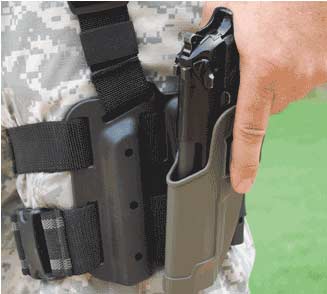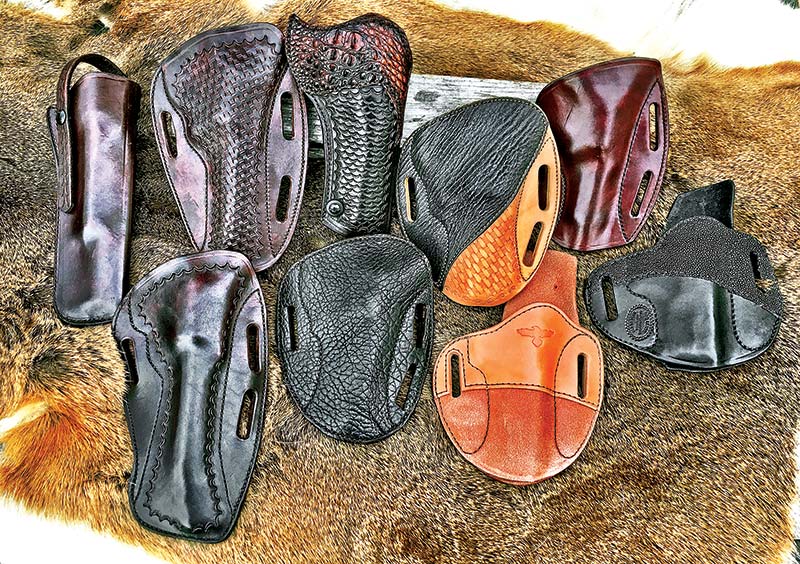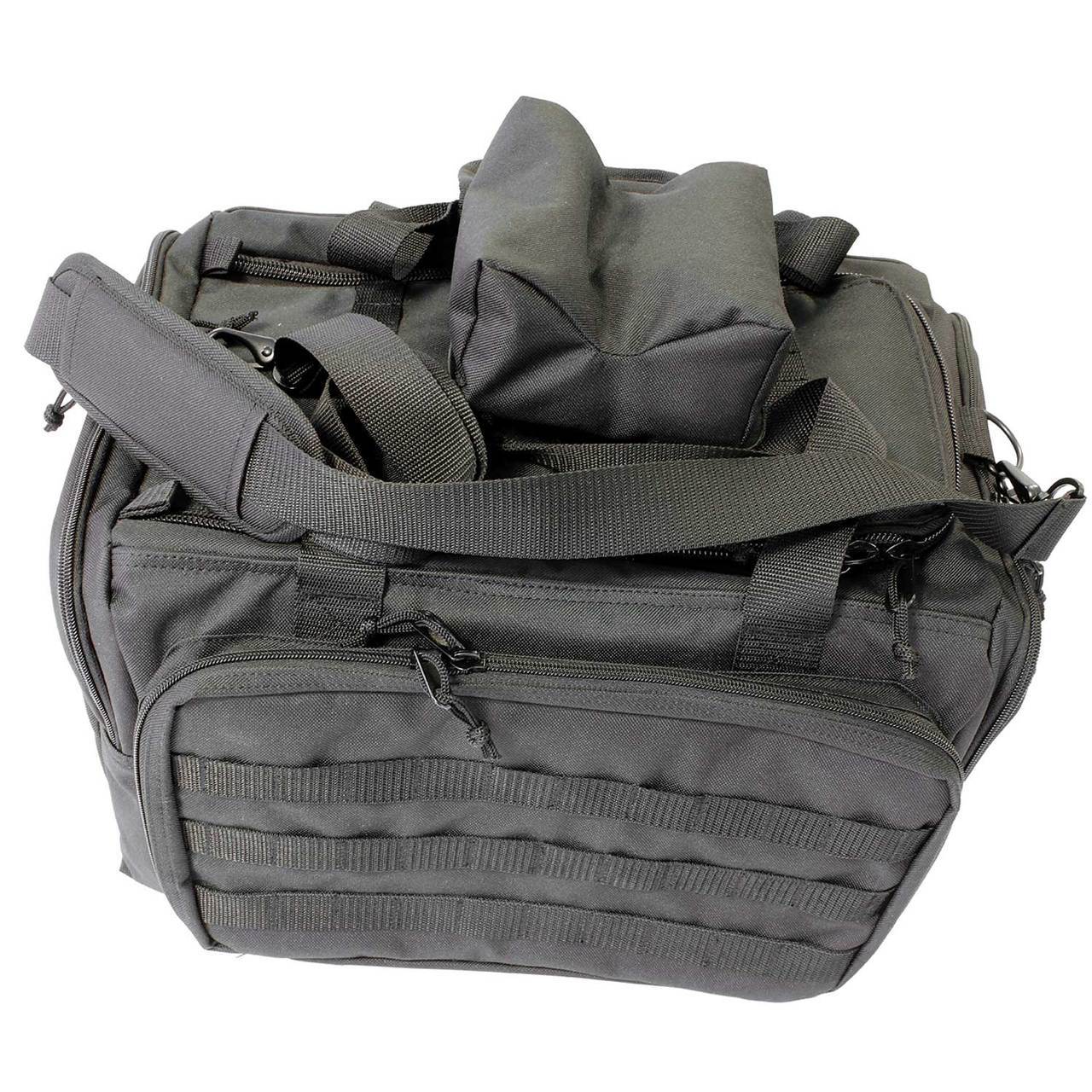
battle_med2
Beretta’s Rack-Grade GI 92FS/M9
The USA’s First Fight Winning 9mm —
Still Performing 30 Years Later.
By Robert Kolesar
I like the 9mm M9 service pistol. It’s been in GI holsters now for over 30 years, it’s fought wars and pacified the streets of many of our cities in civilian dress. It groups quite well for a duty pistol and has an excellent track record in reliability. It now holds every record in the CMP Service Pistol events at Camp Perry. It’s had its share of problems along the way (more on that later), but the Beretta 92FS/M9 has paid its dues.
A rack-grade M9 issued to a USAR Service Pistol Team member, has fired
in excess of 10,000 rounds of GI M882 ball without any malfunctions.
ARMY M9s and magazines ready for annual qualification.
History & Problems
The US military had been trying to get rid of its .45s since the early 1950s. Because of the costs involved—plus the large number of 1911 and 1911A1’s in the system after WW II—it didn’t happen. Fast-forward to the ‘70’s…by then, 1911 stocks were depleted due to combat and attrition, and the issued ones left in inventory were in pretty sad shape. Most had gone through at least one rebuild. I’ve seen some 1911A1s with four rebuild stamps.
In 1979 the JSSAP (Joint Services Small Arms Program) started looking at a replacement. The 1911s and A1s were nearing an end to their service lives. The Army and Marine Corps were short thousands of pistols to arm all its pistol-packing troops. These shortages were partially filled by arming some aviation, CID and MP units with a mishmash of .38 revolvers in 2″ and 4″ barrel lengths. The Air Force used S&W revolvers as their standard sidearm. Spare parts, repair and ammunition requests were becoming a logistical problem throughout the services. It was envisioned one pistol would become the issue sidearm for all the military, not just the combat arms. It would replace the revolvers and ancient .45’s and streamline repair and ammo requests.
In 1985 the Beretta 92SB-F was adopted as the US M9 service pistol. It was a contentious process, with the Army refusing at first to accept the Air Force finding that the Beretta was the superior handgun. In 1982 the testing was re-done, this time by the Army. All entries flunked, including the Beretta. Testing was resumed again in 1983 and ‘84, with Congress denying funding for 1911 parts and .45 ammo until the Army got its act together and picked a new 9mm pistol. The new tests — called the XM-9 Pistol Trials — resulted in the Beretta and SIG contestants passing all accuracy, endurance, environmental and reliability tests. Beretta eventually won the bidding war over SIG for the initial M9 contract. Another round of tests was held in 1988 (XM-10 trials) and the Beretta won again.
After initial adoption, there were several catastrophic slide failures (one resulted in a soldier being injured during a demonstration in front of visiting Army dignitaries) traced to improper heat treatment of initial batches of slides and early, very hot M882 GI ammo. Pressures and velocity were dialed back on issue ammo and slide heat treatment was more closely monitored. In extensive testing, Beretta was unable to replicate any slide or locking block failures using 9mm ammunition falling within the normal pressure range of commercial ammo. Just to be safe, the military mandated all Berettas had to have a “slide catching device” added to the inner slide rail of all military pistols. This would stop pieces of a separated slide from coming back into the shooter’s face if the slide failed during firing. The civilian 92 with the new slide retention catch was renamed the 92FS.
US M9 9mm (top) with the former US issue pistol, an M1911A1 .45. Both are
big pistols, but the M9 has a capacity of 15, compared to the 1911A1’s 7.
M9 fieldstripped for maintenance. The Beretta is an easy pistol to strip
for cleaning and inspection. A thorough cleaning can be done while stripped.
A few drops of oil on the rails after cleaning and it’s time for reassembly.
The main problem I’ve encountered with the M9 is locking block failure. The blocks tend to crack after firing lots of rounds, using GI ball ammo. Not much you can do, except pound the slide off with a rubber mallet to get at the broken locking block. Beretta re-designed the block and hardened it, cutting down on the problem, but it still happens occasionally. Best cure is regular replacement after a few thousand rounds of M882, whether it needs it or not. When I was the NCOIC of the USAR Small Arms Instructor Academy (SAIA), we went through one or two blocks per class, every class. Fifteen school-issued pistols were fired for 6-700 rounds per cycle. After replacement with the newer, hardened locking blocks, our failure rate was down to one or two broken blocks per year.
Civilian 92FS pistols don’t experience the locking block problem—our commercial ammo is pretty mild stuff and doesn’t put as much strain on the pistol. My own 92FS has had in excess of 30,000 rounds through it, still with the original locking block, barrel and extractor.
What gave the M9 an undeserved black eye in combat were malfunctions caused by low-bid magazines issued to troops in Iraq. Two million new magazines — with a better phosphate finish that doesn’t attract dust and sand — have since been purchased and issued. Like many soldiers, I took six of my own Beretta-manufactured magazines along on my Iraq tour and didn’t have any malfunctions.
Shooting Impressions
I’ve shot a bunch of Berettas, both civilian and military. Without exception they were reliable if properly lubed and fed clean factory ammo, loaded in Beretta or newer GI contract magazines.
Beretta M9s have good fixed sights and a smooth, albeit somewhat heavy double-action trigger pull. If the pistol is being issued to me, I’ll blacken out the white dots on the front and rear sights with a magic marker. Plain black sights work best on a service pistol. I’ve found most Beretta sights shoot to point of aim at 15 yards, which is good enough for a duty pistol.
Check issued magazines over carefully, clean and reassemble them without using any oil and ensure the magazine spring hasn’t been reversed (a common mistake guaranteed to cause malfunctions later). Load and carry your magazines to full capacity — the magazine spring can take it. I always carried five, fully loaded magazines and left the sixth one empty. I changed out every 2-3 weeks or so, which was probably over-doing it, but it’s not a bad idea in a combat zone.
Accuracy-wise, the standard M9 will shine in the hands of an accomplished marksman. Hand-held groups of 2″ at 20 yards are common, and some pistols with good ammo (like Atlanta Arms 115-grain match ball) will do considerably better. Accurized M9 National Match pistols, built by Marine and Army Marksmanship Unit armorers, are shooting 10-shot 1 to 1.5″ groups at 50 yards from a machine rest. Not bad for an aluminum-framed combat pistol!
The M9—hated by some and liked by others—is approaching four decades of military service. It’s had a few teething problems, long-since resolved. It’s accurate, low recoiling, very reliable, easy to shoot well and a proven combat veteran. With more than a half-million serving, it’s a sure bet the M9 will see a fifth decade or more of military duty.
The M9A3 (top) with an issue M9. The M9A3 is Beretta’s attempt to give
the Army what it wants in a follow-on next generation pistol while still
using the M9 platform.
The new M9A3 is very comfortable with the redesigned thinner grip. This
target was shot with a new A3 at 20 yards in a series of two-shot drills
from the low ready, using both double and single action.
New & Improved: Beretta’s M9A3
The M9, like all US military weapons, is a work in progress. All have had issues (including the M1, M14 and the M1911) problems were addressed, and all were updated and improved over time. The M9 is no different. Beretta has responded to criticisms of the M9 over the years by constantly upgrading the pistol. The 92SB-F became the 92FS; the Marine Corps replaced the M9 with the M9A1.
The M9A3 is the best version yet of the M9 series. Most noticeable is the grip, which is borrowed from the earlier Beretta Vertec. The M9A3 is really a 92 Vertec, with a few added features like a threaded barrel and a different finish. The grip is thinner and easier to control for shooters with smaller hands. The mag well is beveled and the front and rear straps are aggressively checkered. Despite being noticeably thinner, the new M9A3 magazines hold 17 rounds compared to earlier issue M9 mags which top out at 15. Older 92/M9 mags are also interchangeable with the new ones and will work with both the M9A3 and M9.
The Beretta M9A3 comes with factory-installed Trijicon night sights and a removable dovetailed front sight. A threaded barrel, requested by the military, is part of the improvement package. Not really needed by most civilians, but nice to have anyway. The A3 can also be easily converted to decock-only, like the Model 92G.
I shot a new sample Beretta M9A3 during several range trips using GI M882 ball, Atlanta Arms match and some older Federal commercial flat-nosed stuff I had. All loads grouped very well and to point of aim at 7, 20 and 25 yards. Beretta 92s have always been noted for accuracy and the A3 is no different. Grip comfort was excellent — I really like the flat Vertec backstrap. Double and single action pulls were smooth and light — transition from double to single action was effortless. I had no malfunctions with any of the loads tried. As is the case with all Berettas, proper lubrication of the slide rails guarantees reliability. Despite the cool-looking and very rugged finish (Cerakote earthtone), the M9A3 thrives on liberal amounts of oil applied to the rails.
Beretta has been trying to interest the Department of Defense in adopting the A3 by submitting an M9 ECP (engineering change proposal) without too much success; the Army wants a new pistol. I wouldn’t count Beretta out yet, though; the M4/16 series is still around after several new service rifle trials and tests. There are now over a half-million M9s in US military arms rooms, with more being produced under the latest contract. The M9A3 would make for a seamless logistical transition that is cost-effective without any additional troop training necessary.
US Pistol, M9
Manufacturer: Beretta USA
Caliber: 9mm
Capacity: 15
Weight: 34 oz.
Barrel length: 4.9″
Overall length: 8.5″
Action type: Short recoil semi-automatic, double/single action trigger pull
Sights: Fixed, high-profile 3-dot
Finish: Black “Bruniton,” non-reflective and corrosion resistant
www.beretta.com
Looking For More?
Order Your Copy Of The GUNS Magazine 2016 Surplus, Vintage & Classic Special Edition






















